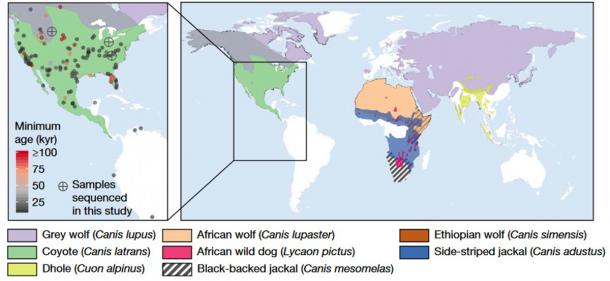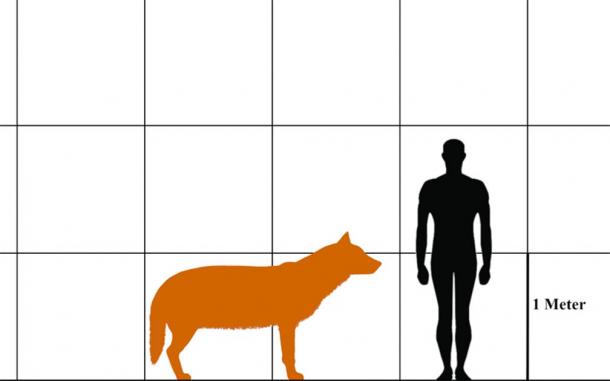
Beyond Game of Thrones: Study Reveals Secrets of Real Dire Wolves
Have you ever heard of dire wolves? You’ll probably say “Yes” if you are a fan of the TV show Game of Thrones. This canine species appears in the iconic TV series, where it is known as a ‘direwolf’ and is the sigil of House Stark; but it also actually roamed North America until around 13,000 years ago. New research shows that the story of dire wolves should not be based on appearances alone.
Real life dire wolves were large, wolf-like (as you might expect), and were one of the most common carnivores to call the Americas home in the Late Pleistocene period (approximately 126,000 to 12,000 years ago). The body shape of this extinct species is so similar to gray wolves that it was assumed that dire wolves and gray wolves were probably close relations. However, the research published in the journal Nature today reveals that this assumption is incorrect.

Dire wolf skeleton from the La Brea Tar Pits mounted in running pose. (Eden, Janine and Jim/CC BY 2.0) Dire wolves were among the most common carnivores in the Americas in the Late Pleistocene period.
Researchers Who Study Dire Wolves Get Surprising Results
The new Nature paper is the work of a diverse international team of experts including researchers from Queen Mary University, Durham University, and the University of Oxford in the UK, the University of California Los Angeles (UCLA) in the US, Australia’s Adelaide University, and Ludwig Maximilian University in Germany.
A Durham University press release states that the international team has completed the first genetic sequencing of ancient dire wolf DNA. The researchers took samples from five dire wolf sub-fossils which were gathered from Wyoming, Idaho, Ohio, and Tennessee. The fossils are between to 12,900 years old to 50,000 years old. By using cutting-edge molecular methods on the genetic samples, the researchers have reconstructed the evolutionary history of the long-extinct carnivore for the first time, and the results are surprising. Co-lead author, Dr. Kieren Mitchell from the University of Adelaide, noted that “Dire wolves are sometimes portrayed as mythical creatures - giant wolves prowling bleak frozen landscapes - but reality turns out to be even more interesting.”
![“Dire wolves are sometimes portrayed as mythical creatures […] but reality turns out to be even more interesting.” (Public Domain)](https://www.ancient-origins.net/sites/default/files/image003_561.jpg)
“Dire wolves are sometimes portrayed as mythical creatures […] but reality turns out to be even more interesting.” (Public Domain)
Lone Wolves
The study shows that dire wolves split from African jackals around 5.1 million years ago and their lineage separated from other wolves approximately 5.7 million years ago – meaning they are only distant relatives of today’s wolves. Senior author, Dr. Laurent Frantz, from the Ludwig Maximilian University of Munich, said, “When we first started this study we thought that dire wolves were just beefed up grey wolves, so we were surprised to learn how extremely genetically different they were.”
- Fossils of Giant Prehistoric Beasts Discovered in Underwater Ice Age Death Cave
- Who’s Afraid of the Big Bad Wolf? A Fearsome Beast in Tales Around the World
- Howling Against the Moon: The Last Wolves of Ireland
The genomic analyses results presented in the Nature paper suggest that there are three primary lineages that descend from a shared ancestor: dire wolves, African jackals, and a group of all the other existing wolf-like species, including the gray wolf.

Left: Map representing the distribution of sites in the Americas where dire wolf remains have been identified. Colored circles represent the locations and approximate ages of the remains, with crossed circles representing the five samples that yielded sufficient DNA to reconstruct both mitochondrial genomes and low-coverage nuclear genome sequences. Right: Map of the geographical range of the canid species investigated in this study. (Perri, A.R. et al./Nature)
Co-lead author, Dr. Alice Mouton from UCLA says:
“We have found the dire wolf is not closely related to the grey wolf. Further we show that the dire wolf never interbred with the grey wolf. In contrast, grey wolves, African wolves, dogs, coyotes and jackals can and do interbreed. Dire wolves likely diverged from grey wolves more than five million years ago, which was a great surprise that this divergence occurred so early. This finding highlights how special and unique the dire wolf was.”
The researchers found that dire wolves were so different from other canine species, like coyotes and gray wolves, that they could not even breed with each other. Dr. Frantz says this is surprising because “Hybridization across Canis species is thought to be very common, this must mean that dire wolves were isolated in North America for a very long time to become so genetically distinct.”

Skeletons of gray (Canis lupus) and dire wolf (Canis dirus). (Mariomassone & Momotarou2012/CC BY-SA 3.0)
Dr. Kieren Mitchell further explained that “Despite anatomical similarities between gray wolves and dire wolves - suggesting that they could perhaps be related in the same way as modern humans and Neanderthals - our genetic results show these two species of wolf are much more like distant cousins, like humans and chimpanzees.” Dr. Mitchell continued,
“While ancient humans and Neanderthals appear to have interbred, as do modern grey wolves and coyotes, our genetic data provided no evidence that dire wolves interbred with any living canine species. All our data point to the dire wolf being the last surviving member of an ancient lineage distinct from all living canines.”

Size comparison of a dire wolf and a human. (Aledgn/CC BY-SA 4.0)
The Origins and Extinction of Dire Wolves
A UCLA press release on the study says that over the years researchers have excavated more than 4,000 dire wolves from the La Brea Tar Pits in Los Angeles, California, USA. But before the current study, scientists were in the dark about their evolution and the reason for their extinction. “The terrifying dire wolf, a legendary symbol of Los Angeles and the La Brea Tar Pits, has earned its place among the many large, unique species that went extinct at the end of the Pleistocene epoch,” co-senior author Robert Wayne of UCLA said.
The genetic analysis also shows that this extinct canid species originated in the Americas. In comparison the ancestors of gray wolves, coyotes, and dholes evolved in Eurasia and arrived in North America later, around 1.37 million years ago.
Now that the family story and origins of the dire wolf are covered, it’s time to turn to another major question – what happened to them?
The researchers didn’t cover this question in-depth in their research, but the common belief is that the large body size of Canis dirus, meaning ’fearsome dog’ (dire wolves’ scientific name), suggests they preyed on large mammals like bison. When there was a massive megafauna extinction, the researchers suggest that the dire wolves lack of interbreeding with other wolf-like species to acquire other traits may have hastened their demise.
Top Image: Somewhere in Southwestern North America during the late Pleistocene, a pack of dire wolves ( Canis dirus) are feeding on their bison kill, while a pair of gray wolves (Canis lupus) approach in the hopes of scavenging. One of the dire wolves rushes in to confront the gray wolves, and their confrontation allows a comparison of the bigger, larger-headed and reddish-brown dire wolf with its smaller, gray relative. Source: Mauricio Antón/ Nature
















Comments
Hi All,
I'll say this I thought the Dingo's in Australia were the Dire Wolves but, that they had shrunk because the Natural World; that belonged to them, had changed because of the shifting Ice Age they just got stuck in Australia.
Learning their Ancestry lies more so with The African Jackal and other Dog Like species is enlightening. Great article.
Until next time Everyone, Goodbye!